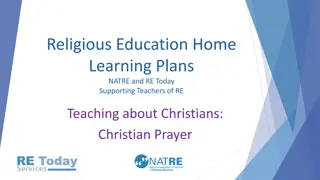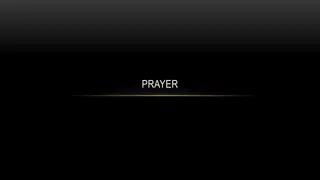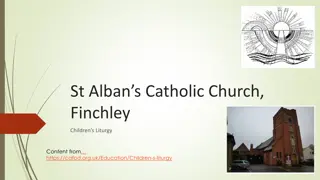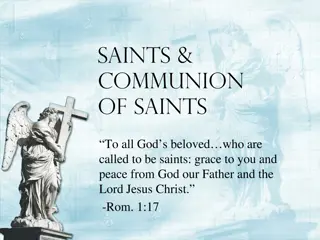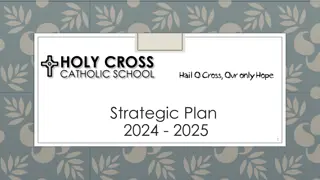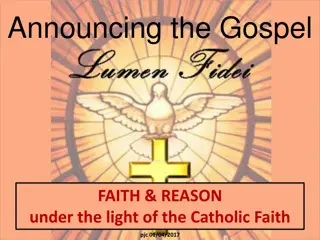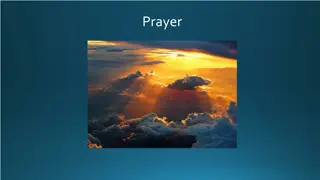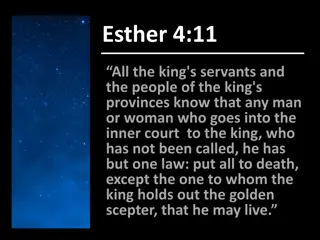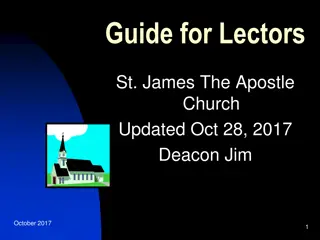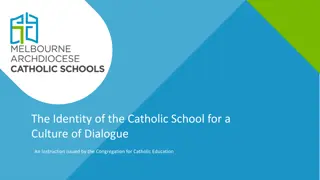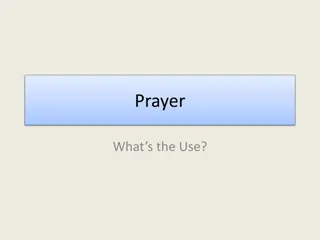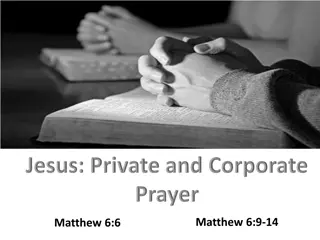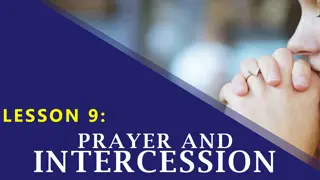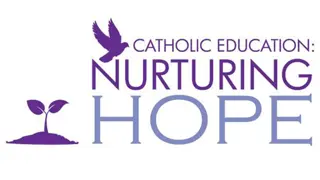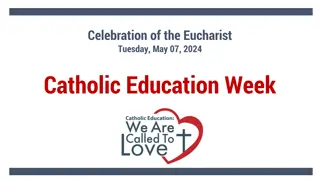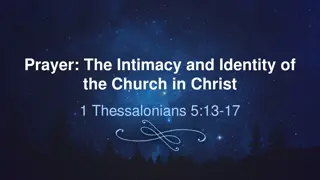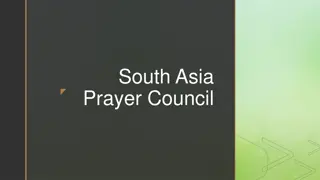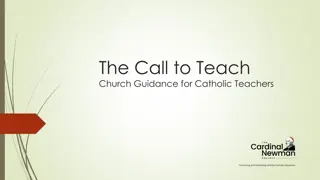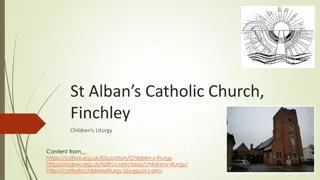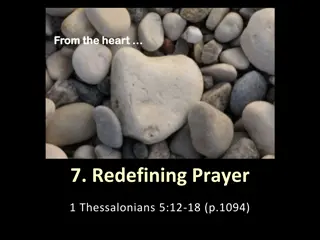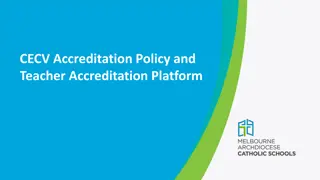Reflecting on Catholic School Prayer and Liturgy: A Journey of Faith and Education
Explore the intersection of faith and education in Catholic schools through the lens of prayer and liturgy, guided by the new Prayer and Liturgy Directory. Delve into the essence of worship, the importance of holding onto our beliefs, and the role of Jesus Christ in shaping the ethos of Catholic education. Discover how the Directory aims to elevate practices and inspire a deeper connection to faith within school communities.
Download Presentation

Please find below an Image/Link to download the presentation.
The content on the website is provided AS IS for your information and personal use only. It may not be sold, licensed, or shared on other websites without obtaining consent from the author. Download presentation by click this link. If you encounter any issues during the download, it is possible that the publisher has removed the file from their server.
E N D
Presentation Transcript
RE Subject Leaders Autumn 2023 WELCOME
R: My help shall come from the Lord Who made heaven and earth. Psalm 121
How do we hold onto things we have lost? Who do you want to hold onto?
Let us pray together: Lord God, Creator of all people, you have made us creatures olf this earth but have also promised us a share in eternal life. May all who have died share this eternal life with your saints in heaven, where there is neither sorrow nor pain, but everlasting life. We ask you this through Christ our Lord, Amen.
To know you more dearly To know you more dearly The new Prayer and Liturgy Directory The new Prayer and Liturgy Directory What it is: We hope that this Directory will affirm what is good practice, while also setting a high bar to which all can aspire. In the language of the Catholic Church, a Directory draws together material from Church documents and applies them to a particular context It is for Catholic schools, Academies and Colleges in England and Wales. We have until 2025-2026 to fully implement. What do I hope to do today? An opportunity to begin to unpack the sections of the Directory. To share some key messages from the Directory To recognise where we are already meeting the requirements and to suggest ways in which we can begin to move towards full implementation over a number of years.
1. Introduction Part One 2. Contexts 3. Understanding Prayer and Liturgy Part 2 4. The school community 5. The school community at prayer and liturgy Part 3 6. Looking at Prayer and Liturgy 7. Models of Prayer and Liturgy 8. Application 9. Appendices References
Introduction Introduction Through him, with him and in him, O God, almighty Father, in the unity of the Holy Spirit, all glory and honour is yours, for ever and ever. Amen. To worship is to recognise that we are not the centre of the universe, that our life and all we are is a gift from God, and that our ultimate destiny does not lie within our control. Pg 1
Introduction Introduction Just as Our Lord Jesus Christ is at the heart of all our prayer and liturgy, so too he is at the centre of every Catholic school. His Gospel is the reference point for its ethos and values; he offers the definitive example of the educator The quality of the prayer and liturgy in school not only gives honour to God but forms the spiritual and ethical life of pupils and staff alike. Pg 3
Fit for Mission? Schools. Pillar 2: Sacraments Fit for Mission? Schools. Pillar 2: Sacraments A sacrament is both sign and instrument (Lumen Gentium, 1), therefore it requires active participation in the liturgical action; it is not simply something to be passively consumed or witnessed but is a reality that must be realised by everyone involved (Sacrosanctum concilium (SC 7). The ministry of the Word is fundamental to the school as an evangelical and catechetical community. Therefore, it is expected that the Word of God is proclaimed at all collective worship. It must never be replaced by another secular or religious text. Liturgy and Prayer should follow the liturgical seasons, which, over the course of the year, unfolds the whole mystery of Christ opening up the riches of our Lord s prayer, powers and merits
Understanding prayer and liturgy Understanding prayer and liturgy The community of a Catholic school will generally be inclusive of people who are not Catholics or Christians. This context provides Catholic schools with a unique opportunity to present, in an authentic way, our tradition of Catholic prayer and liturgy, while at the same time providing a welcoming environment for all pupils and staff. In order to respond to this most fruitfully, we are called to understand the tradition of the Catholic faith and maintain an approach that respects the integrity of all members of the school community. Pg 6
Understanding prayer and liturgy Understanding prayer and liturgy It is important for schools to experience the richness and diversity of the Church s prayer and liturgy. To offer a limited range risks narrowing the school community s access to opportunities for spiritual growth and experience of the Catholic tradition. Celebration of the word Reconciliation Mass Benediction Classroom prayer Liturgy of the Hours Common prayers Angelus Rosary Individual prayer Pg 38 Processions and Pilgrimages Stations of the Cross Grace before and after meals Beginning and end of the day
Fit for Mission? Schools. Pillar 4: Prayer Fit for Mission? Schools. Pillar 4: Prayer Through teaching meditation on the Word of God, young people will learn that Scripture does not contain mere dead letters about a dead past, but rather Scripture contains words of life addressed to each of them individually by the living God. This is why we must also meditate on the Word of God in the liturgy of the Church, because it is only through the Church that we participate in the living body of Christ Teach children and young people to meditate on the Word of God in personal prayer. Practise meditation on the Word of God in liturgical prayer. Introduce children and young people to popular piety, such as the Holy Rosary, Stations of the Cross, Devotion to the Sacred Heart/ Divine Mercy, etc. The meaningful memorization of basic prayers offers an essential support to the life of prayer (CCC 2688). A certain memorisation of the words of Jesus, of important Bible passages, such as psalms and canticles, the Ten Commandments, the Creeds, liturgical texts, essential prayers, far from being opposed to the dignity of young Christians, or constituting an obstacle to personal dialogue with the Lord, is a real need (Pope John Paul, Catechesi Tradendae, 55)
Model Prayer and Liturgy Policy Model Prayer and Liturgy Policy 4. Overview of prayer and liturgy provision [In this section of the policy, an overview of the provision is given. It will outline when prayer and liturgy take place, and the daily and weekly pattern of prayer and liturgy offered in the school. It will also include when Mass is celebrated across the year, when there are opportunities for the Sacrament of Reconciliation, and when there are special liturgies. This section of the policy is similar to but less detailed than the Annual Plan of Provision. The Annual Plan of Provision will include, for example, dates, who is responsible, and much more detail.] page 69-72
Prayer in the primary school Prayer in the primary school There is a long tradition of Christians learning prayers and phrases of scripture by memory. This was not only the consequence of a pre-literate society, but a way to provide people with core texts which they could call upon when needed. We speak about learning prayers by heart so that they can spring from the heart. Pg 46
Participation in the liturgy Participation in the liturgy A key concept in the renewal of the Church s liturgy is participation . The Church desires that participation in the liturgy should be full, conscious and active . Pg 11
Participation in the liturgy Participation in the liturgy Ministry Those who assist in the liturgy, whether by leading, reading, or singing, serve by facilitating the participation of all who are present at the liturgical assembly. They should be well formed and properly prepared because it is important in our worship of God that we offer something which is worthy. Allocating roles, such as reading or leading intercessions, should not be treated as a means of distributing tasks to pupils and staff in order to generate participation. Pg 12
Prayer, liturgy and inclusion Prayer, liturgy and inclusion In a Catholic school, all corporate prayer and liturgy will be celebrated from within the Catholic tradition, but this does not mean that the fruits of the celebration are limited only to Catholic pupils and staff. Times of prayer can provide a space for all to reflect on their spiritual journey, be nourished by what they see and hear, and be encouraged to live lives in the service of others. Pg 20
Prayer, liturgy and inclusion Prayer, liturgy and inclusion- - some key quotes some key quotes Pope Francis provided three fundamental guidelines to help dialogue, the duty to respect one s own identity and that of others, the courage to accept differences, and sincerity of intentions Catholic pupils and staff will have different levels of religious literacy and varied personal experiences of, and engagement with, prayer and liturgy. In prayer and celebrations of the word, there is great scope for other Christians to take distinct roles for example, by reading from scripture or leading the Intercessions Pupils and staff from other faith traditions will bring to prayer in school, alongside their Christian colleagues, their joys, hopes, sorrows 23 and those of their families and communities. Other Christian staff and pupils are invited to participate in the celebration of the Sacraments of the Eucharist and Reconciliation through joining in the prayers and music, listening to the word of God, and sharing in the postures and gestures of the liturgical assembly. Their participation is also internal, as what is being celebrated engages with their own faith. In times of prayer, it is wholly appropriate to invite students and staff to reflect in silence together on their needs and the needs of the world, and to name those intentions out loud when invited. A suitable response might be found in the Christian tradition, perhaps taken from the Book of Psalms. This can respect both the integrity of the individual and the Catholic nature of the school. The entire celebration forms a whole, so that the proclamation of the scriptures flows through the General Intercessions into the Eucharistic Prayer and the reception of Holy Communion, which are inextricably linked in an indivisible manner. Therefore, the Church anticipates that only those who normally receive Holy Communion at Mass be invited to proclaim the word of God, for example. It is never appropriate to incorporate texts, objects, and ritual practices from other religions into Catholic prayer and liturgy. we do not come to pray together, but we come together to pray
Prayer, liturgy and inclusion Prayer, liturgy and inclusion the school accompanies all its members as each person walks her or his spiritual journey, whatever its starting point. This calls for a knowledge and understanding by the school leaders of the various religious traditions represented in their school, a capacity to facilitate listening and dialogue on the part of all staff, and a respectful openness to the other from all members of the school community. Within this frame, the expectation that our Catholic schools should be authentically inclusive necessarily involves a respect and openness to difference. Pg 20
Christs Presence in the Liturgy Christ s Presence in the Liturgy 1. 2. 3. In the person of the minister at Mass. (Especially) in the Eucharistic species. In the sacraments when a person baptises, it is really Christ himself who baptises. In the scriptures it is he himself who speaks when the holy scriptures are read in Church. In the singing and the praying of the liturgical assembly for he promised, Where two or three are gathered in my name, there am I in the midst of them (Mt. 18:20). 4. 5.
A key purpose of liturgical ministry: To facilitate that inclusion on the part of all present, while respecting their particular circumstances and faith positions. So, ministry, is an act of service performed by members of the Church to all who are present: It is an exercise of their baptismal participation in the three-fold priesthood of Christ. That act of service has as its primary objective to draw/include them into the worship of Christ. Who above all is doing the liturgical work on behalf of the people? ANSWER: CHRIST THE GREAT HIGH PRIEST. So, we need to ask for whom this would not be appropriate?
A couple of delicate spots:(1) Reading at Mass and the Sacraments: what the Directory states is the formal position of the Catholic Church, which has not changed. What is behind this position? The proclamation of the Word of God in the liturgy is a ministry an act of service performed by the members of the Church to all those present; It is not simply a human act: as the reader speaks, the Holy Spirit is active in the congregation, without exception; So, the reader gifts their voice so that all present may be drawn into this encounter between God and humanity: inclusion lies in hearing the Word, and the reader s role as minister is to facilitate this inclusion. The focus is not so much on the reader, but on the congregation: how best are they helped to participate in hearing the Word?
Yes but why does the reader have to be a Catholic? Underlying principle: the celebration of the liturgy is a formal action of the Church. (see SC, 26). The proclamation of the Scriptures in the Liturgy, therefore, is also a formal act of the Church through which God speaks. Therefore, the one who ministers the Word in the Liturgy represents the Church in that ministry, and so should themself be in full communion with the Catholic Church. A bishop has the right, under particular circumstances and on acase by case basis, to exempt from this rule. In Celebrations of the Word: it is entirely appropriate that members of other Christian communities should read from the Scriptures and lead the intercessions.
A couple of delicate spots (2): Members of Other Faiths Leading, Joining in Prayers Again, differentiate between the celebration of the Liturgy and Celebrations of the Word/Prayer. In the Liturgy: Principle focus: the worship offered by Christ; leading prayers is a ministry just as in Mass; so the same understanding applies through its minister, the Church invites all present to include themselves in the Prayer made by the Church to the Father. So it is not appropriate for members of other faiths to read from the scriptures or to lead the intercessions.
In Celebrations of the Word There is greater scope for creativity but here the question of attending to the integrity of members of other faith communities must be taken into mind. It is not appropriate to ask Jewish or Muslim members of the school community to: Read from the Christian scriptures Make a prayer Through Christ Conclude any prayer in a Trinitarian form. Make the sign of the Cross. For Muslims, in addition: God should not be addressed as Father For Muslims, anything that compromises the oneness of God is regarded as shirk an extremely grave sin indeed.
Looking at Prayer and Liturgy Looking at Prayer and Liturgy Ritual is a fundamental human activity. The word designates a structured group activity that uses words, gestures, symbols, and movement that have been used by others over time. Human beings use rituals to express some of the things that are significant to them, such as their shared identity Pg 26
Looking at Prayer and Liturgy Looking at Prayer and Liturgy Scripture: The proclamation of scripture is essential to the liturgy and celebrations of the word. Scripture readings cannot be replaced by other texts. When the Gospel is proclaimed, it should be a high point and celebrated with signs of reverence Pg 26
Looking at Prayer and Liturgy Looking at Prayer and Liturgy Symbol: Authenticity: in celebrations of the word and liturgy, symbols are meant to be used. For example, the symbolic use of light is to illuminate, highlight, and provide a clear focus. Therefore, candles and other lights should have a symbolic function rather than being merely decorative. Maintain the focus: within prayer and liturgy, symbols need their own space so that they can speak. It is best to use one appropriate symbol as a clear focus rather than many, which can introduce confusion. Generosity: make sure that the symbol is able to engage with and affect the senses of participants. A minimalist approach (a drop of water, a dab of oil, a symbol that cannot be seen) is unlikely to produce the desired impact. Pg 27
Looking at Prayer and Liturgy Looking at Prayer and Liturgy The body in prayer and liturgy It is important to be attentive to the physical, embodied aspects of prayer and liturgy. Pupils should be confident in the postures and gestures of prayer and liturgy, and use them in expression of their faith and prayer Pg 28
Looking at Prayer and Liturgy Looking at Prayer and Liturgy Silence: Times of silence should ideally be found in any prayer or liturgy Pg 28
Looking at Prayer and Liturgy Looking at Prayer and Liturgy Music: When choosing music for the liturgy, priority should be given to singing the texts of the liturgy, such as the Gospel Acclamation and the Acclamations in the Eucharistic Prayer. In prayer and celebrations of the word, opportunities should be sought for regular singing. Schools should aim to have a varied repertoire which is suitable for singing in the liturgy, drawing on music which has stood the test of time. Pg 31
Looking at Prayer and Liturgy Looking at Prayer and Liturgy Times and Seasons: The marking and counting of time is part of what makes us human. From the beginning of our lives to their end, we are framed by time The school year is cyclical: we start afresh in September, looking forward to the familiar shape of the term ahead . The annual cycle of the Church s liturgical year is centred on Christ and, in particular, on how he has made salvation possible for us. The year is, then, a sequence of seasons which brings into focus the various aspects of the one mystery of salvation in Christ, who is present in his Church. Pg31-32
Looking at Prayer and Liturgy Looking at Prayer and Liturgy Places and objects The classroom is a place of prayer in all school settings. In a primary school, there would normally be a prayer space in each classroom often a table, which would usually reflect the liturgical season with an appropriately coloured cloth and other seasonal items. It might also feature a crucifix, a candle, a Bible, and an interactive opportunity, such as a class/home prayer book. There might also be a class patron Saint represented by an icon and other artefacts In all settings, there would be a focus of some kind in the reception area and assembly hall, and any monitors or displays in reception would be used to reflect the religious character of the school. The liturgical season would also be evidenced in common areas for example, a Remembrance Book on display in November. Pg 36
Models of Prayer and Liturgy Models of Prayer and Liturgy 7.3 Celebrations of the Word 7.4 Mass 7.5 Reconciliation 7.6 Other liturgies 7.7 Other times of Prayer 7.8 Forms of Prayer and Devotions 7.9 Individual Prayer 7.10 Common prayers
Business Business Twilight clusters this term 4.00- 5.00pm in host schools RED Branches 4-6 CPD : 16th January Preston, 17th January Workington. Help required for Branch 5. EYFS, Y&3 Spring Term 10-12 and 1.00- 3.00, same venues as in Autumn: 22/1/2024- J36 24/1/2024- Carlisle 29/1/2024- Preston 30/1/2024- Blackpool Twilights to follow in second half of spring term RE Subject leaders in Preston on 12th March and Carlisle on 13th March Suggestions for future cpd for P&L



